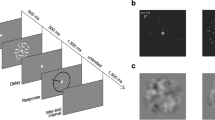Summary
In visual perception complex movements are usually split up into components — e.g., in such a way that a moving reference system is applied, to which partial movements can be related. In the following experiment a perceptual vector analysis of this kind was investigated. It was shown that 1) a radial translatory movement (relative component) can be isolated perceptually from a rotatory movement (global component) and that 2) the precision of this decomposition of the complex movement is dependent on the strength at which the rotating reference system is anchored perceptually.
Similar content being viewed by others
References
Börjesson, E., von Hofsten, C.: Spatial determinants of depth perception in two-dot motion patterns. Percept. Psychophys. 11, 263–268 (1972)
Börjesson, E., von Hofsten, C.: Visual perception of motion in depth: Application of vector model to three-dot motion patterns. Percept. Psychophys. 13, 169–179 (1973)
Börjesson, E., von Hofsten, C.: A vector model for perceived object rotation and translation in space. Psychol. Res. 38, 209–230 (1975)
Braunstein, M.L.: Depth perception through motion. New York: Academic Press 1976
Gogel, W.C.: Relative motion and the adjacency principle. Quart. J. Exp. Psychol. 26, 425–437 (1974)
Hochberg, J., Fallon, P.: Perceptual analysis of moving patterns. Science 194, 1081–1083 (1976)
Hochberg, J., Fallon, P., Brooks, V.: Motion organization in “stop action” sequences. Scand. J. Psychol. 18, 187–191 (1977)
Johansson, G.: Configurations in event perception. Uppsala: Almquist & Wiksell 1950
Johansson, G.: Perception of motion and changing form. Scand. J. Psychol. 5, 181–208 (1964)
Johansson, G.: Visual perception of biological motion and a model of its analysis. Percept. Psychophys. 14, 201–211 (1973)
Johansson, G.: Vector analysis in visual perception of rolling motion. Psychol. Forsch. 36, 311–319 (1974)
Johansson, G.: Spatio-temporal differentiation and integration in visual motion perception. Psychol. Res. 38, 379–393 (1975/76)
Johansson, G.: Spatial constancy and motion in visual perception. In: Stability and constancy in visual perception: Mechanisms and processes, Epstein, W. (ed.). New York: Wiley 1977
Kalveram, K.Th.: Das Marburger System. 1. Teil: Das Digital-System. 2. Teil: Das Analog-System. Berichte aus dem Institut für Psychologie der Universität Marburg Nr. 44, 1975
Author information
Authors and Affiliations
Additional information
The authors wish to thank M. Rauterberg for collecting the experimental data
Rights and permissions
About this article
Cite this article
Kalveram, K.T., Ritter, M. The formation of reference systems in visual motion perception. Psychol. Res 40, 397–405 (1979). https://doi.org/10.1007/BF00309419
Received:
Issue Date:
DOI: https://doi.org/10.1007/BF00309419




